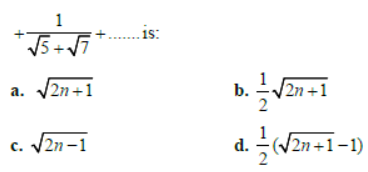Please refer to Assignments Class 11 Mathematics Sequences and Series Chapter 9 with solved questions and answers. We have provided Class 11 Mathematics Assignments for all chapters on our website. These problems and solutions for Chapter 9 Sequences and Series Class 11 Mathematics have been prepared as per the latest syllabus and books issued for the current academic year. Learn these solved important questions to get more marks in your class tests and examinations.
Sequences and Series Assignments Class 11 Mathematics
Question.

a. e + 1
b. e – 1
c. 1 – e
d. e
Answer
B
Question. The 19th term from the end of the series 2 + 6 + 10 + …. + 86 is:
a. 6
b. 18
c. 14
d. 10
Answer
C
Question. The sum of all odd numbers of two digits is:
a. 2475
b. 2530
c. 4905
d. 5049
Answer
A
Question. Let r T be rth term of an A.P. whose first term is a and common difference is d. If for some positive integers m, n, m ≠ n, Tn, 1/n = and Tn, 1/m = , then a – d equals?
a. 1/m+1/n
b. 1
c. 1/mn
d. 0
Answer
D
Question. The sum of the first and third term of an A.P. is 12 and the product of first and second term is 24, the first term is:
a. 1
b. 8
c. 4
d. 6
Answer
C
Question. Let two numbers have arithmetic mean 9 and geometric mean 4. Then these numbers are the roots of the quadratic equation:
a. x2 −18x −16 = 0
b. x2 −18x +16 = 0
c. x2 +18x −16 = 0
d. x2 +18x +16 = 0
Answer
B
Question. If r S denotes the sum of the first r terms of an A.P., then S3r – Sr-1 / S2r – S2r-1 is equal to:
a. 2r – 1
b. 2r + 1
c. 4r + 1
d. 2r + 3
Answer
B
Question. The numbers (√2 +1),1, (√2 −1) will be in:
a. A.P.
b. G.P.
c. H.P.
d. None of these
Answer
B
Question. If sum of n terms of an A.P. is 3n2 + 5n and 164 m T = , then m =?
a. 26
b. 27
c. 28
d. 29
Answer
B
Question. The sum of n terms of the series


Answer
D
Question. If (1–t1)+(2–t2) +……+(n2–tn) = 1/3 n(n2–1) then tn is:
a. n/2
b. n −1
c. n +1
d. n
Answer
D
Question. If a1 , a2 , an+1 + are in A.P., then


Answer
D
Question. The number of terms in the series 101+ 99 + 97 +…..+ 47 is:
a. 25
b. 28
c. 30
d. 20
Answer
B
Question. If x,2x + 2,3x + 3 are in G.P., then the fourth term is:
a. 27
b. – 27
c. 13.5
d. – 13.5
Answer
D
Question. The first term of an infinite geometric progression is x and its sum is 5. Then:
a. 0 ≤ x ≤10
b. 0 < x <10
c. −10 < x < 0
d. x >10
Answer
B
Question. 1+ 3/2+5/22+7/23 +…..∞ is equal to:
a. 3
b. 6
c. 9
d. 12
Answer
B
Question. The G.M. of the numbers 3, 32,33 ……3n is:
a. 32/n
b. 3n+1/2
c. 3n/2
d. 3n-1/2
Answer
B
Question. If a, b, c are in A.P. as well as in G.P., then:
a. a = b ≠ c
b. a ≠ b = c
c. a ≠ b ≠ c
d. a = b = c
Answer
D
Question. The two geometric mean between the number 1 and 64 are:
a. 1 and 64
b. 4 and 16
c. 2 and 16
d. 8 and 16
Answer
B
Question. If the sum of the first 2n terms of 2, 5, 8…. is equal to the sum of the first n terms of 57, 59, 61…., then n is equal to:
a. 10
b. 12
c. 11
d. 13
Answer
C
Question. The 4th term of a H.P. is 3/5 and 8th term is 1/3 then its 6th term is:
a. 1/6
b. 3/7
c. 1/7
d. 3/5
Answer
B
Question. If the first and the (2n – 1) th term of an AP, GP and HP are equal and their nth terms are a,b and c respectively, then: A,B,
a. a = b = c
b. a ≥ b ≥ c
c. a + c = b
d. ac − b2 = 0
Answer
D
Question. The harmonic mean of the roots of the equation
2 (5 + √2)x − (4 + √3) x +8 + 2√3 = 0 is:
a. 2
b. 4
c.6
d. 8
Answer
B
Question. The nth term of the series 3 + 10 + 17 + ….. and 63 + 65 + 67 + …… are equal, then the value of n is:
a. 11
b. 12
c. 13
d. 15
Answer
C
Question. If a, b, c are in G.P., a − b, c − a, b − c are in H.P., then a + 4b + c is equal to:
a. 0
b. 1
c. −1
d. None of these
Answer
A
Question. If a,b,c are in H.P., then the value of (1/b + 1/c – 1/a) (1/c + 1/a – 1/b) is:

Answer
C
Question. Sum of the series1+ 2.2 + 3.22 + 4.23 +….+100.299 is:
a. 100.2100 +1
b. 99.2100 +1
c. 99.2100 −1
d. 100.2100 −1
Answer
B
Question. In a certain A.P., 5 times the 5th term is equal to 8 times the 8th term, then its 13th term is:
a. 0
b. – 1
c. – 12
d. – 13
Answer
A
Question. The sum to n terms of the series 1 + 3 + 7 + 15 + 31 +… is:
a. 2n+1 – n
b. 2n+1 – n –2
c. 2n – n –2
d. None of these
Answer
B
Question. A series whose nth term is (n/x)+y , the sum of r terms will be:

Answer
A
Question. 1/q + r ,1/r + p, 1/p + q are in A.P. then,
a. p, q, r are in A.P
b. p2, q2, r2 are in A.P
c. 1/p, 1/q, 1/r are in A.P
d. p + q + r are in A.P
Answer
B
Question. If the sum of first p terms of an A.P. is equal to the sum of the first q terms then the sum of the first p + q. terms, is
a. 0
b. 1
c. 2
d. 3
Answer
A
Question. In a G.P. of even number of terms, the sum of all terms is 5 times the sum of the odd terms. The common ratio of the G.P. is
a. −4/5
b. 1/5
c. 4
d. None of these
Answer
C
Question. Match the terms given in column-I with the terms given in column-II and choose the correct option from the codes given below.

Codes
A B C D
a. 1 2 3 4
b. 1 4 2 3
c. 3 4 2 1
d. 3 2 4 1
Answer
D
Question. If 1/a, 1/b, 1/c are the pth, qth, rth terms respectively of an A.P. then the value of abp – q. + bc q – r. + ca r – p. is
a. –1
b. 2
c. 0
d. –2
Answer
C
Question. The 10 th common term between the series 3 + 7 + 11 + …. and 1 + 6 + 11 + …. is
a. 191
b. 193
c. 211
d. None of these
Answer
A
Question. If the arithmetic, geometric and harmonic means between two distinct positive real numbers be A, G and H respectively, then the relation between them is
a. A > G > H
b. A > G < H
c. H > G > A
d. G > A > H
Answer
A
Question. If the ratio of H.M. and G.M. of two quantities is 12 : 13, then the ratio of the numbers is
a. 1 : 2
b. 2 : 3
c. 3 : 4
d. None of these
Answer
D
Question. How many terms of the geometric series 1 + 4 + 16 + 64 + … will make the sum 5461?
a. 3
b. 4
c. 5
d. 7
Answer
D
Question. If m arithmetic means are inserted between 1 and 31 so that the ratio of the 7th and m – 1.th means 5 : 9, then the value of m is
a. 10
b. 11
c. 12
d. 14
Answer
D
STATEMENT TYPE QUESTIONS
Question. I. Three numbers a, b, c are in G.P. iff b2 = ac
II. The reciprocals of the terms of a given G.P. form a G.P.
III. If a1, a2, …, an…. is a G.P., then the expression a1 + a2 + … + an + … is called a geometric series.
Choose the correct option.
a. Only I and II are true
b. Only II and III are true
c. All are true
d. Only I and III are true
Answer
C
Question. Consider the following statements.
I. A sequence is called an arithmetic progression if the difference of a term and the previous term is always same.
II. Arithmetic Mean A.M.. A of any two numbers a and b is given by 1/2a + b. such that a, A, b are in A.P.
The arithmetic mean for any n positive numbers a1, a2, a3, ….., an is given by
A.M. = a1 + a2 + … + an/n
Choose the correct option.
a. Only I is true
b. Both are true
c. Only II is true
d. Both are false
Answer
B
Question. I. 18th term of the sequence 72, 70, 68, 66, … is 40.
II. 4th term of the sequence 8 – 6i, 7 – 4i, 6 – 2i, … is purely real.
Choose the correct option.
a. Only I is true
b. Only II is true
c. Both are true
d. Both are false
Answer
B
Question. Statement I: Three numbers a, b, c are in A.P., then b is called the arithmetic mean of a and c.
Statement II: Three numbers a, b, c are in A.P. iff 2b = a + c.
Choose the correct option.
a. Only I is true
b. Only II is true
c. Both are true
d. Both are false
Answer
C
Question. I. 37 terms are there in the sequence 3, 6, 9, 12, …, 111.
II. General term of the sequence 9, 12, 15, 18, … is 3n + 8.
Choose the correct option.
a. Only I is true
b. Only II is true.
c. Both are true
d. Both are false
Answer
A

